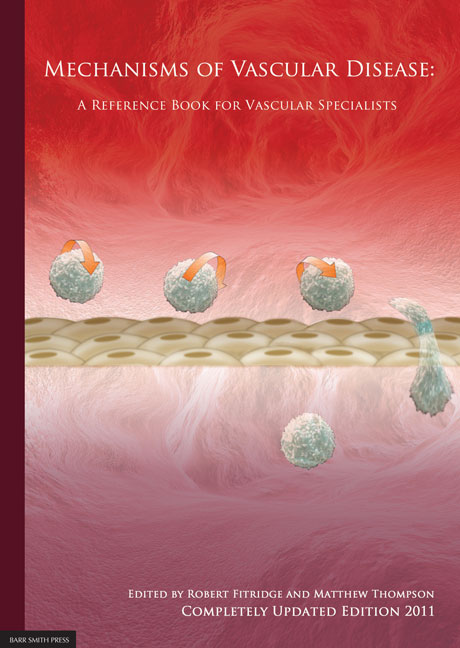Book contents
- Frontmatter
- Contents
- List of Contributors
- Detailed Contents
- Acknowledgements
- Abbreviation List
- 1 Endothelium
- 2 Vascular smooth muscle structure and function
- 3 Atherosclerosis
- 4 Mechanisms of plaque rupture
- 5 Current and emerging therapies in atheroprotection
- 6 Molecular approaches to revascularisation in peripheral vascular disease
- 7 Biology of restenosis and targets for intervention
- 8 Vascular arterial haemodynamics
- 9 Physiological Haemostasis
- 10 Hypercoagulable States
- 11 Platelets in the pathogenesis of vascular disease and their role as a therapeutic target
- 12 Pathogenesis of aortic aneurysms
- 13 Pharmacological treatment of aneurysms
- 14 Pathophysiology of Aortic dissection and connective tissue disorders
- 15 Biomarkers in vascular disease
- 16 Pathophysiology and principles of management of vasculitis and Raynaud's phenomenon
- 17 SIRS, sepsis and multiorgan failure
- 18 Pathophysiology of reperfusion injury
- 19 Compartment syndromes
- 20 Pathophysiology of pain
- 21 Post-amputation pain
- 22 Treatment of neuropathic pain
- 23 Principles of wound healing
- 24 Pathophysiology and principles of varicose veins
- 25 Chronic venous insufficiency and leg ulceration: Principles and vascular biology
- 26 Pathophysiology and principles of management of the diabetic foot
- 27 Lymphoedema – Principles, genetics and pathophysiology
- 28 Graft materials past and future
- 29 Pathophysiology of vascular graft infections
- Index
13 - Pharmacological treatment of aneurysms
Published online by Cambridge University Press: 05 June 2012
- Frontmatter
- Contents
- List of Contributors
- Detailed Contents
- Acknowledgements
- Abbreviation List
- 1 Endothelium
- 2 Vascular smooth muscle structure and function
- 3 Atherosclerosis
- 4 Mechanisms of plaque rupture
- 5 Current and emerging therapies in atheroprotection
- 6 Molecular approaches to revascularisation in peripheral vascular disease
- 7 Biology of restenosis and targets for intervention
- 8 Vascular arterial haemodynamics
- 9 Physiological Haemostasis
- 10 Hypercoagulable States
- 11 Platelets in the pathogenesis of vascular disease and their role as a therapeutic target
- 12 Pathogenesis of aortic aneurysms
- 13 Pharmacological treatment of aneurysms
- 14 Pathophysiology of Aortic dissection and connective tissue disorders
- 15 Biomarkers in vascular disease
- 16 Pathophysiology and principles of management of vasculitis and Raynaud's phenomenon
- 17 SIRS, sepsis and multiorgan failure
- 18 Pathophysiology of reperfusion injury
- 19 Compartment syndromes
- 20 Pathophysiology of pain
- 21 Post-amputation pain
- 22 Treatment of neuropathic pain
- 23 Principles of wound healing
- 24 Pathophysiology and principles of varicose veins
- 25 Chronic venous insufficiency and leg ulceration: Principles and vascular biology
- 26 Pathophysiology and principles of management of the diabetic foot
- 27 Lymphoedema – Principles, genetics and pathophysiology
- 28 Graft materials past and future
- 29 Pathophysiology of vascular graft infections
- Index
Summary
BACKGROUND
Abdominal aortic aneurysms (AAAs) are present in 5 to 10% of men over the age of 65, and elective surgical intervention has long been the mainstay of treatment. There is widespread consensus that operative repair is the treatment of choice in larger AAAs, where the risk of rupture increases with the size of the aneurysm. However, even elective operations carry a significant mortality risk, and the UK small aneurysm trial has shown that for smaller aneurysms (between 4 and 5.5cm) there is no difference in outcome between operation and no intervention. Currently such patients are treated with best medical therapy, but there has been considerable research into finding a pharmacological treatment to prevent aneurysm expansion and rupture.
SCREENING PROGRAMMES
A major obstacle to the prevention of mortality and morbidity associated with aneurysms has been the fact that the majority are asymptomatic, and therefore often remain undetected. Abdominal aortic aneurysms have tended to present either as emergencies or as a result of their increasing size, and it has been shown that larger aneurysms grow more rapidly than their smaller counterparts and are at greater risk of rupture. These patients would therefore benefit most from operative repair rather than medical intervention. In order for a medical treatment to be of benefit, it needs to be targeted at aneurysms that are small and asymptomatic. The most obvious way of doing this would be the initiation of a mass screening programme, and indeed, the Multicentre Aneurysm Screening Study (MASS) has shown that as many as 88% of screen-detected aneurysms are below the threshold for surgery.
- Type
- Chapter
- Information
- Mechanisms of Vascular DiseaseA Reference Book for Vascular Specialists, pp. 247 - 254Publisher: The University of Adelaide PressPrint publication year: 2011



